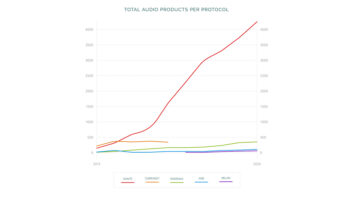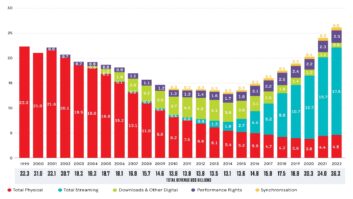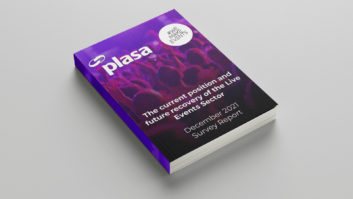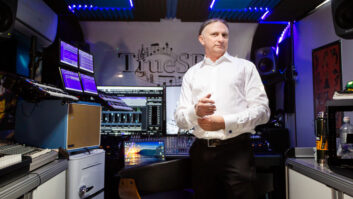
Held in a convention center that dwarfs the annual WInter NAMM Show’s home in Anaheim, the annual Musikmesse international trade fair and its show-within-a-show, Prolight + Sound, took place in Frankfurt, Germany, from April 10 to April 13. Over the course of four days, more than 2,000 exhibitors demonstrated products in multiple halls throughout each day. Each year I’ve attended, I’ve learned to make a direct dash to Halls 5 and 8, which contain the products I’m most interested in seeing from music production, live sound and recording studio equipment manufacturers.
This report highlights the top items I saw during Musikmesse/Prolight + Sound 2013.

AKG K612 PRO
Hand-crafted in Austria, the K612/K712 PRO headphones models from AKG both are open, over-the-ear headphones with a self-adjusting genuine leather headband, aluminum arches and solid rivet construction. The K612 PRO model is designed for professional monitoring, whereas the K712 PROs are designed for mixing and mastering and feature a detachable cable.

Allen & Heath Qu-16
The impressively versatile 19-inch rack-mountable Allen & Heath Qu-16 digital mixer is compatible with Allen & Heath’s ME Personal Mixing System and features 16 mono inputs (TRS + XLR), three stereo inputs (TRS), four stereo FX returns, 16 buses, 12 mix outputs (L/R; mono mix 1-4; stereo mix 1-3), four FX engines, AES digital out, moving faders, recallable AnaLOGIQ preamps, Qu-Drive direct multitrack recording and playback on USB drives, an 800×480-pixel touchscreen, iLive FX library, dSNAKE Remote Audio Port, and more.

Avid Pro Tools 11 metering options
Avid was showing off the newly-announced Pro Tools 11, which adds a wide range of new features to the company’s flagship software app. Pro Tools 11 is now a fully 64-bit app with its all-new Avid Audio Engine, promising multiple times the processing power of Pro Tools 10 to allow the use of more virtual instruments and effects plug-ins in your sessions. Pro Tools 11’s meters are a bit taller; you can expand all Send views while also using a mini meter on the mix console screen. In fact, Pro Tools 11 has 16 different metering types in all, delivering an impressive array of choices for maintaining levels in your sessions. A much-requested feature is finally here with Pro Tools 11’s new Offline Bounce to Disk, which not only delivers faster bouncing of your mixes, but also allows for simultaneous bouncing of 16 multichannel stems and the ability to bounce a bus individually. On the down side, older Mac Pro users who’ve been shut out of running OS X Mountain Lion will also find themselves shut out of Pro Tools 11, as it requires OS X Mountain Lion to operate. Pro Tools 11 is slated for release in Q2 of 2013 and is offered in a wide range of upgrade and cross-grade pricing packages.

B-Band UKKO contact microphones
Although it isn’t a new product from this small company renowned for its acoustic guitar pickup systems, the B-Band UKKO contact microphones with preamps for drums caught my eyes and ears. This is a clever system designed to eliminate the need for drum microphones by placing a pickup system inside of the drums, connected through the air hole on the side of the drum to a preamp system, which in turn has an XLR connector and is styled to look like a lug connector on a standard drum.

Clear-Com HelixNet Partyline
Running a large production sound and lighting system requires solid communication abilities between the various front and back of house lighting and sound stations. Clear-Com again addresses this need by delivering their new network party-line intercom system. HelixNet Partyline delivers stellar audio clarity, with central administration of the entire system from the Main Station with a single cable and flexible cable options with the ability to leverage an existing cable infrastructure. The HelixNet Partyline line comprises the HMS-4X Main Station, HBP-2X HelixNet Beltpack, HLI-2W2 two-wire interface module, HLI-4W2 four-wire interface module, HLI-ET2 Ethernet linking module and HLI-FBS Fiber linking module. HelixNet Partyline is an all-digital platform based on I.V.Core Technology that uses a wideband of CODECS, low latency from an intelligent decision engine, and noise-reduction and error-recovery through proprietary algorithms optimized for human voice characteristics.

Focusrite Scarlett 18i20
Focusrite’s Scarlett 18i20 is the USB 2 version of the company’s Sapphire audio interface, and is the latest in the company’s new generation of multichannel USB-based audio interfaces, featuring eight Focusrite microphone preamplifiers, designed specifically for the computer interface environment offering low noise, minimal distortion and a large dynamic range.

Genelec M040
One of the most trusted names in studio monitors, Genelec, announced their new M Series studio monitors during Prolight + Sound 2013 at Musikmesse. The powered monitors are designed to be energy-efficient and even when I listened to them on the noisy show floor, it was obvious that these monitors live up to the Genelec reputation for amazing sound from the demo I heard at the booth. The company showed off the first two models, the M030 and the M040 bi-amplified active monitors. The M Series models feature new Class-D amplifiers that are highly efficient, low distortion amplifiers that operate cooler and lighter than Class-A/B amps. They also feature Intelligent Signal Sensing (ISS) power management with auto power-off/auto power-on and with the standby power consumption of less than 0.5 watts. Automatic voltage selection allows the monitors to operate throughout the world. Additionally, the M Series has high-performance drivers, intuitive room response controls and system calibration with XLR/TRS and unbalanced RCA inputs.

JBL M2 Master Reference Monitors
JBL showed off its new M2 Master Reference Monitors. These free-standing, 2-way systems can be placed in any environment to provide an exceptionally accurate monitoring experience. Using its new generation of JBL high-output, ultra-low distortion transducers, the M2 provides in-room frequency response of 20 Hz to 40 kHz, and 123dB maximum SPL.

Native Instruments KOMPLETE 9
Native Instruments’ KOMPLETE 9 and KOMPLETE 9 Ultimate are both must-have investments for any production studio seeking a unified solution to providing your projects and your clients’ projects with a “komprehensive” source of outstanding-sounding virtual instruments, guitar amp and effects modeling, and soft synths. KOMPLETE 9 includes more than 12,000 sounds in 120GB of data with 33 virtual instruments and effects for $559 U.S., making this package a bargain compared to buying all of the products individually for about $5,200 U.S., saving more than 80 percent with the package.
For a literal “ultimate” upgrade at $1,099 U.S., KOMPLETE 9 Ultimate offers 65 software titles from Native Instruments on a hard drive containing more than 370GB of data and more than 16,000 sounds. KOMPLETE 9 Ultimate would cost $10,240 U.S. if bought individually. For my money, this was the best value-for-price software package that I saw while at Prolight + Sound 2013/Musikmesse. For the price of a handful of some companies’ plug-ins, Native Instruments is offering pretty much their entire product line in one gigantic package. It’s an investment in their platform as much as an investment in high-quality tools for audio and music production, and considering what you get for the investment, either KOMPLETE 9 or KOMPLETE 9 Ultimate are both sound investments for your studio.

AMS Neve 1073N
AMS Neve’s modular Neve 1073N is built from the same 1073 mic preamp and EQ module components that are used in the company’s mixers. The Neve 1073N can operate in standalone mode as a mic pre, providing phantom power, and that classic Neve sound, and its shipping now for approximately $2,495.

RME MADIface XT
RME announced summer shipping for the new MADIface XT, OctaMic XTC and MADIface USB, the first USB 3 audio interface to hit the market. The MADIface XT has three MADI I/Os with 64 channels each, two mic/line inputs, two XLR line and one stereo phones output, plus one AES/EBU I/O for a total of 196 audio inputs and 198 audio outputs, along with MIDI ports via USB, MADI and DIN. The XT uses external PCI Express and USB 3.0 to guarantee hi-speed data transfer. It also features TotalMix FX, can be used completely stand-alone, remote controlled via MIDI and much more.

RME OctaMic XTC
The OctaMic XTC is RME’s self-described Swiss Army Knife of all of its interface offerings. It offers eight channel mic/line/instrument preamplifier with 192kHz/24-bit A/D conversion, AutoSet, four channel D/A conversion for analog or digital input monitoring. OctaMic XTC also has full MIDI remote control via USB, DIN and MADI, plus ADAT, AES and MADI optical outputs, as well as full-channel inputs that are easily patched and routed with the TFT display, turning the XTC into a full-featured digital format converter. The MADIface USB is the industry’s first USB 3 audio I/O in a compact bus-powered device that provides MADI I/O via USB2 while supporting the format’s full 64 channels.

LSP 500 PRO P.A. system
Sennheiser previewed its new Wireless Systems Manager Version 4, which assists users in setting up and coordinating the frequencies of wireless microphones and personal monitors by having the most important parameters handily displayed on a single screen. The software also gives a detailed overview of the spectrum, of blocked channels, of the devices to be integrated into the set-up and of the reliability of selected frequencies. And speaking of apps, the new LSP 500 PRO P.A. system from Sennheiser also offers simple control via an app. The wireless loudspeaker ensures that the P.A. system for any event can be set up quickly—without the need for cabling—with an app that enables up to 20 loudspeakers to be remotely controlled at the same time. The entire P.A. system is controlled by the LSP 500 PRO app, which essentially takes over the functions of a mixing console. Configurations can be set either for individual speakers or for groups of speakers as well as for the audio sources connected to them.

SSL Live console
Solid State Logic’s booth was one of the most exciting, where the company announced the launch of ‘Live,’ the first SSL console for live sound production, bringing SSL’s unique approach to audio quality and console ergonomics to sound for the stage.
I’m told that Peter Gabriel, a majority owner of SSL, was interested in getting the Live console into production early on in his involvement with SSL. The features of the new SSL Live console are far too numerous to list here, but suffice it to say that SSL has packaged everything under the sun into this amazing new live sound console, including multiple tablet style multi-gesture with a giant 19-inch touchscreen for complete control functionality over Live’s 976 inputs and outputs and 192 audio “paths” (144 full and 48 dry) at 96 kHz. All processing is built into the console surface and it has a collection of I/O connectivity built into the frame. Live is due to ship in September 2013.

SSL Sigma
Solid State Logic also unveiled Sigma, a remote controlled dual rackspace analog mix engine that is remote controlled using MIDI via Ethernet using a DAW or an iDevice compatible software interface. Using proprietary MDAC control technology first featured in SSL’s Duality and AWS studio consoles, Sigma’s 100-percent analogue summing engine can be driven by automation data created within your DAW of choice.

SSL Stereo Bus Compressor
The SSL Stereo Bus Compressor for 500 Series format modular racks is based on the center section compressor from SSL’s 1980s G-Series analog console, which is designed to make complete mixes sound bigger, with more power, punch and drive.

Soundcraft Si Expression mixers
In the digital mixer world, Soundcraft demonstrated its Si Expression series offering a lot of features at an affordable price point. The line includes a portable 19-inch rackmount 16-input Expression 1 unit; a 24-input Si Expression 2; up to the Si Expression 3 featuring 30+2 faders and 32 mic/line inputs. Each Si Expression system features recallable mic preamps with busses, output processing and connectivity to match the versatility of the inputs. Each bus mix features a compressor, 4-band EQ, BSS graphic EQ and delay. All models feature 16 balanced line outputs, headphone monitor out, AES out and a 64×64 option slot. The Si Expression series features mono mic inputs, four line inputs, color touchscreen interface, a possible 66 channels to mix, Pre/Post selection per input per bus, AES in and out, Global mode encoders, Soundcraft FaderGlow, GEQ on every bus, 20 subgroup /aux buses, four FX buses, eight Matrix buses, Left/Right and Center Mix buses.

Steinberg WaveLab 8
Steinberg featured demos of its flagship products Cubase and WaveLab, which recently announced a new version release. Steinberg announced WaveLab 8 audio editing and mastering software, which is a major update offering new speaker management, loudness metering and processing, plug-ins from iZotope and Voxengo, plus many more features and enhancements. WaveLab also features single-window plug-in management, a master control panel, iZotope’s MBIT+ master dither, Voxengo’s CurveEQ, brickwall limiter and tube compressor, SuperClips, metadata support and more than 150 improvements to its user interface and comprehensive tool set.

Universal Audio Apollo 16
The folks at Universal Audio used their time wisely at the show to announce the Apollo 16 audio interface. With 16×16 analog I/O, this FireWire/Thunderbolt–ready interface combines high-quality converters and flexible routing with powerful onboard UAD-2 QUAD processing of its wide array of stellar plug-ins. Apollo 16 features DB-25 connectivity and multi-unit cascading for up to 32×32 analog I/O.
With its standard UAD-2 QUAD processing onboard, Apollo 16 allows real time processing with UAD Powered Plug-Ins allowing engineers to monitor, audition, and “print” audio using analog emulations from Ampex, Lexicon, Manley, Neve, Roland, SSL, Studer, and more from UA’s assortment of plugin offerings. Apollo 16’s onboard UAD processing is also available during mixing and mastering, so that music producers can employ UAD plug-ins (VST, RTAS, AU) throughout the creative process. Apollo 16 is equipped with 16×16 analog I/O via convenient DB-25 connections. Two Apollo 16 units can be cascaded over MADI for an expanded system with eight UAD processors and 32×32 simultaneous analog I/O, capable of handling large professional mixes. Dedicated XLR monitor outputs and stereo AES/EBU digital I/O round out the Apollo 16’s rear panel audio connections. Apollo 16’s routing capabilities include four stereo cue mixes with individually assignable outputs, and a new “Virtual I/O” feature that allows for Real-time UAD Processing of DAW tracks and virtual instruments. Apollo 16 also offers compatibility with Intel’s high-bandwidth Thunderbolt technology on Macs via a user-installable dual-port Thunderbolt Option Card. Thunderbolt provides greater UAD plug-in instances, improved performance at high sample rates, and reduced UAD plug-in latency in the DAW versus Apollo’s standard FireWire connection.
Interested in building your own mixer from top-quality components, or looking for a certain sound that can only come from a legendary brand name console, but without having to invest in the entire console? Vintagetools.de showed off some really cool modules crafted together from various components of legendary consoles. Their Website is worth a visit for any tone-head.
German company Zynaptiq demonstrated two new plug-ins at the show: Unchirp and Unfilter, which were shown as prototypes and are available as AudioUnits, AAX Native, RTAS and VST for both Mac and Windows operating systems.

Zynaptiq Unchirp
Unchirp is a real-time plug-in that removes the most objectionable artifacts associated with low bit-rate lossy audio encoding, de-noising, and other processes that operate in the frequency domain, commonly referred to as Chirping, Warbling, The Tweeties or Underwater-Sound. This type of artifact has so far been virtually impossible to remove due to its narrow-band and short-time nature. Unchirp salvages poorly encoded music, speech that has gone through a poor GSM/satellite uplink, footage recorded with consumer mobile devices, and material that has been de-noised too aggressively.
Unfilter is a real-time plug-in using a blind de-convolution process to remove filtering effects, such as comb filtering, resonance, or excessive equalization, effectively linearizing the frequency response of a signal virtually automatically. Unfilter also removes slow moving flanger/chorus effects, and can apply a detected filter response to another signal, or store it for later use. Applications include repairing poorly miked production sound or musical recordings, adapting multiple sounds to be in the same acoustic “world,” removing “boominess” or resonance, generally re-balancing the spectral contour of a signal or creatively designing new sounds.

Zynaptiq Pitchmap
Zynaptiq also demonstrated its mind-boggling flagship product, Pitchmap, the world’s first plug-in that allows processing the pitch of individual sounds within mixed signals in real-time. It lets you change the melodies and harmonies of any recording by simply playing your own on a MIDI keyboard or creating a pitch map using their streamlined GUI, which optionally corrects any tuning issues at the same time. As if that weren’t enough, Pitchmap provides functions to remove or extract individual sounds from a mix, and can apply advanced synthesizer-like sound transformations to your audio. In short, it is an inspiring musical instrument—a precision corrective tool and the only processor that literally lets you shape music with your hands. You can literally change the pitch and key of a stereo mix or individual track in ways that have to be seen and heard to be believed. Pitchmap is available now as an AU plug-in.
Finally: This had to be seen to be believed! The heaviest of heavy metal bands was made up of pneumatic, hydraulic robots playing real instruments; guitar, bass and drums. Triggered by MIDI by behind the scenes puppet-masters, and complete with moving fingers to pluck, strum and strike, this robot band performed at the Agora Stage, sponsored by Gibson and drew massive crowds with each performance. Watch ‘Compressorhead Ace of Spades’ on YouTube.
Musician, pro audio publisher and author Mike Lawson has covered the Prolight + Sound/Musikmesse show for Mix magazine since 2009, and serves as Executive Director of the Technology Institute for Music Educators. Visit www.ti-me.org for more information.







